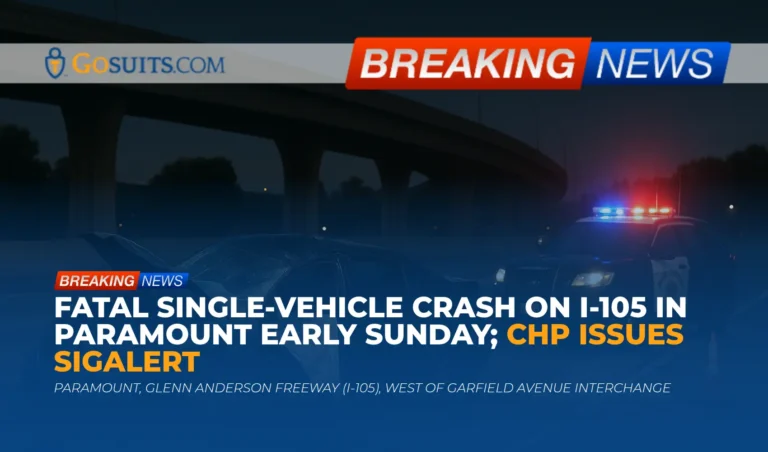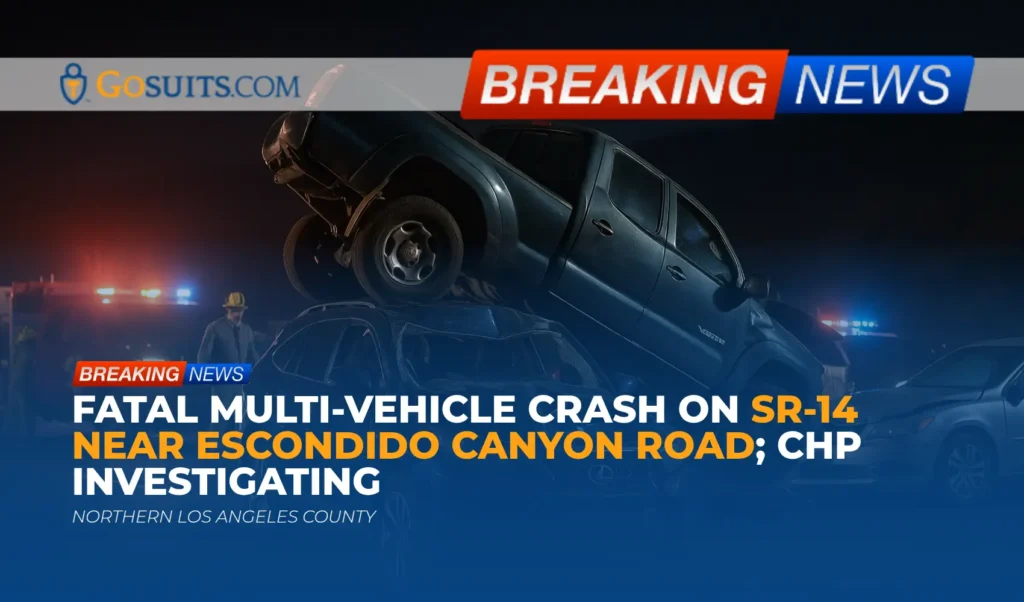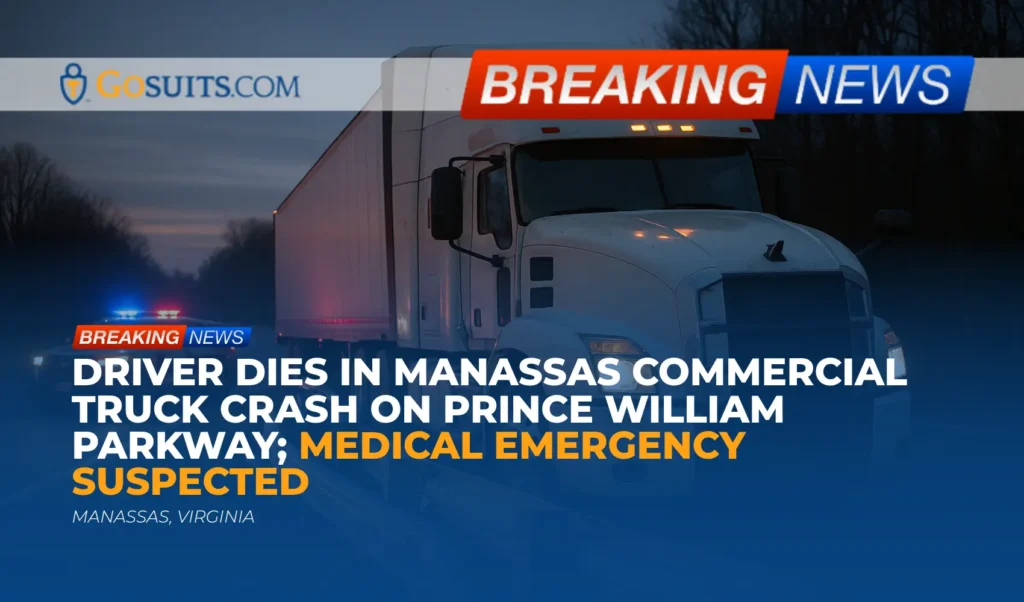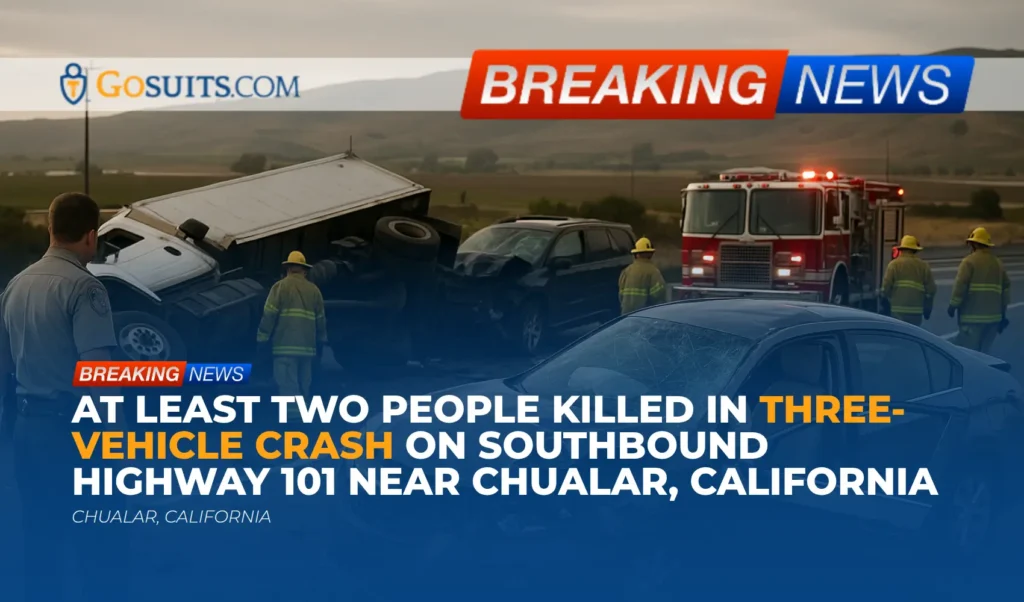- What we know so far about the Paramount freeway fatal crash
- Location, time, and responding agencies
- How investigators approach single-vehicle fatal crashes
- Steps that often help in the first 72 hours
- How to get official records and who to call
- Potential civil liability pathways in a single-vehicle fatality
- Insurance issues after a fatal crash in California
- Preserving evidence and understanding legal timelines
- Community safety and infrastructure considerations on the Glenn Anderson Freeway
- Support and practical resources during a difficult time
- Action steps that should not wait
- Commentary from Gosuits Paramount, California Personal Injury Attorney
What we know so far about the Paramount freeway fatal crash
Authorities reported that a person was killed in a single-vehicle crash on the Glenn Anderson Freeway (Interstate 105) in Paramount early Sunday morning. According to the California Highway Patrol, the collision occurred at approximately 3:30 a.m. on the eastbound lanes, west of Garfield Avenue. A SigAlert was issued at 3:58 a.m., and motorists were advised to avoid the area or consider alternate routes. As of the most recent public update referenced here, no additional details about the vehicle, contributing factors, or the identity of the person who died had been released.
This article offers general information to help community members understand what typically happens after a fatal freeway crash, what records are available, and what rights and processes may apply in the civil context. It does not speculate about the cause of this particular collision.
Location, time, and responding agencies
The crash reportedly took place on the Glenn Anderson Freeway (I-105) eastbound in the city of Paramount, west of the Garfield Avenue interchange, at about 3:30 a.m. Based on the location, the California Highway Patrol (CHP) would lead the collision investigation for incidents on state freeways in Los Angeles County. Fire and emergency medical services typically respond alongside CHP in fatal incidents. The CHP’s SigAlert was issued at 3:58 a.m. and serves as a public notice of significant traffic impacts. Caltrans may assist with traffic management and road safety measures while the scene is secured and investigated.
When a fatality occurs on a freeway in Los Angeles County, the Los Angeles County Department of Medical Examiner is generally responsible for the determination of cause and manner of death and for notifying next of kin.
How investigators approach single-vehicle fatal crashes
Although specific findings in this incident are not yet public, investigators commonly examine a combination of environmental, mechanical, and human factors in single-vehicle crashes. This includes roadway conditions, lighting, weather, debris, tire and brake condition, potential vehicle defects, roadway design elements, visibility, and any potential involvement of other vehicles that may have left the scene. They also review event data recorders (vehicle “black boxes”), onboard safety systems, and available camera footage.
National data indicate that single-vehicle crashes account for a substantial share of traffic fatalities each year. The National Highway Traffic Safety Administration maintains the Fatality Analysis Reporting System, a nationwide census of fatal crashes, which offers context for these patterns without speaking to any single case’s cause or fault. For more on national fatal crash data, see the NHTSA resource on FARS at nhtsa.gov.
Importantly, “single-vehicle” describes the crash configuration, not necessarily legal responsibility. Liability can hinge on many factors, such as roadway hazards, defective components, unsafe work zones, or actions by other road users that are not immediately obvious.
Steps that often help in the first 72 hours
In the immediate aftermath of a fatal freeway crash, families and those assisting them often face urgent decisions while grieving. The following practical steps can help safeguard information and options, while remaining respectful of the ongoing law enforcement and medical examiner processes.
- Identify the investigating CHP Area office. Note the exact location and time of the crash and the incident number if available. The CHP Area office that handled the scene will be the point of contact for the collision report and many updates. A directory of CHP Area offices is available at chp.ca.gov. The CHP non-emergency number is 1-800-TELL-CHP.
- Record what you know. Write down dates, times, locations, and any details shared by responders. Save any texts, call logs, or photos related to the event.
- Preserve the vehicle and personal effects. If a tow company has possession of the vehicle, request in writing that no one dismantle or alter it until it can be inspected. Keeping the vehicle intact can be critical to understanding what happened.
- Hold off on detailed insurance statements. Before speaking at length with any insurance adjuster, consider getting a free consultation with a qualified attorney. Statements made early on can be used later by insurers to limit or deny claims.
- Identify potential video sources. Freeway cameras, nearby businesses, and dashcams may contain valuable footage. Timely requests improve the chance of preservation.
- Monitor Medical Examiner communications. In Los Angeles County, the Department of Medical Examiner will coordinate with next of kin about identification and release procedures and the availability of reports.
How to get official records and who to call
Several official records can help families understand what happened. Many of these are public records, though some may be available only to certain parties or after particular steps are completed. Below are typical sources in an I-105 fatality in Los Angeles County.
California Highway Patrol collision report
The investigating CHP Area office prepares a collision report. Under California law and CHP policy, collision reports are generally available to parties of interest, which can include the registered owner, the driver, passengers, legal guardians, and the legal representative of someone who is deceased. Reports can be requested using the CHP’s collision report request process and the CHP 190 form. For information about requesting a CHP collision report, visit the California Highway Patrol’s official site at chp.ca.gov and navigate to collision report requests or CHP Area office contact pages.
The report may include diagrams, statements, scene measurements, and, when applicable, references to evidence such as event data recorders. Supplemental reports can be added as the investigation develops.
Los Angeles County Department of Medical Examiner records
The Los Angeles County Department of Medical Examiner typically provides case status information, autopsy and toxicology (where performed), and final cause and manner of death statements. Availability and timing vary by case. Information on requesting records is posted at the Department’s official portal: me.lacounty.gov. Look for “Request Records,” “Case Records,” or similar sections on that site to find request procedures, identification requirements, and any fees.
Death certificate
Certified death certificates in Los Angeles County are issued by the Registrar-Recorder/County Clerk. Requests, eligibility criteria, and ordering methods are explained at the County’s official site: lavote.gov.

Public records and 911 audio
Some materials such as 911 audio, CAD logs, and certain communications may be obtainable through a California Public Records Act request, subject to exemptions. General information about the Public Records Act is available from the California Attorney General at oag.ca.gov. For freeway incidents, CHP is often the custodian of many responsive records; local fire departments may hold separate records for their response.
Traffic management and incident timing
Caltrans manages freeway operations and may have lane-closure, incident timing, and maintenance records. For system-wide traffic and incident information, Caltrans posts tools such as QuickMap at quickmap.dot.ca.gov. While QuickMap is primarily for real-time traffic awareness, it can sometimes help corroborate timing of closures and SigAlerts referenced by agencies.
Potential civil liability pathways in a single-vehicle fatality
While single-vehicle collisions can sometimes be attributed to driver factors, that is not always the full story. From a civil perspective, several pathways may be considered depending on the facts uncovered by the investigation.
- Roadway condition and maintenance. If a dangerous condition of public property contributed to the crash, there may be a civil claim against the responsible public entity, subject to strict notice and deadline rules under the Government Claims Act. See California Government Code section 911.2 for claim deadlines at leginfo.legislature.ca.gov.
- Work zone or contractor negligence. Improper traffic control, inadequate lighting, or unsafe work zone setup by a contractor can form a basis for liability. Contracts with Caltrans or other agencies can indicate responsibility for signage and safety compliance.
- Vehicle defect or failure. Brakes, steering components, tires, and safety systems can fail. If a defect contributed, potential product liability claims may arise against a manufacturer or supplier. Preserving the vehicle and its event data is crucial.
- Third-party actions. Another motorist’s sudden movement, debris spillage, or unsafe merge can precipitate a single-vehicle crash even if that other party does not collide with the victim’s car. Witnesses, dashcams, and traffic cameras may reveal these dynamics.
- Rideshare, employer, or commercial vehicle factors. If the decedent was working at the time or in a commercial context, the employer’s policies, maintenance practices, and insurance coverage may be relevant.
California’s wrongful death law outlines who may bring a civil action and on what basis. Eligible family members are identified in Code of Civil Procedure section 377.60, available at leginfo.legislature.ca.gov. The statute establishes who may seek damages such as certain economic contributions and non-economic losses recognized by law.
Insurance issues after a fatal crash in California
Insurance coverage can be layered and complicated in freeway fatalities. The policies potentially in play may include the decedent’s policy, other drivers’ policies if implicated by evidence, employer or commercial policies, uninsured/underinsured motorist coverage, and in some cases public entity risk pools if a dangerous road condition is involved.
- Uninsured/underinsured motorist (UM/UIM). UM/UIM coverage can apply even in single-vehicle scenarios if evidence later shows a “phantom vehicle” or unidentified driver caused the crash. Policy language and proof requirements vary.
- Medical payments and funeral benefits. Some auto policies include medical payments coverage that can assist with certain costs regardless of fault, subject to policy terms.
- Insurer communications. Insurance adjusters often seek recorded statements early. Consider consulting an attorney before giving any detailed statement; what is said can be used later to limit claims.
- California Department of Insurance. If there are concerns about unfair claim practices or delays, consumers can review resources and complaint processes at the California Department of Insurance: insurance.ca.gov.
California law also requires that the driver or owner of a vehicle involved in a collision causing injury or death submit an SR-1 report to the DMV within 10 days, regardless of fault, in many circumstances. The DMV provides information regarding the “Report of Traffic Accident Occurring in California (SR-1)” at dmv.ca.gov. When a driver has died, a representative may handle applicable filings; speak with counsel for guidance tailored to the situation before submitting significant paperwork or statements.
Preserving evidence and understanding legal timelines
Time can be critical after a fatal crash. Evidence may be lost and legal deadlines can arrive quickly.
- Vehicle preservation. Send written notice to the tow yard and any insurer holding the vehicle instructing that the vehicle be preserved for inspection and that no destructive testing occur without agreement.
- Event Data Recorder (EDR). Many vehicles store pre-crash data. Extraction generally requires specialized tools. Early preservation helps avoid data loss from battery disconnects or subsequent movement.
- Witnesses and video. Identify potential witnesses and request nearby businesses to retain evidence. Freeway interchange areas sometimes have cameras; while many are not recording, some agencies or private entities capture useful video.
- Statute of limitations. In California, many wrongful death actions must be filed within two years of the date of death. See Code of Civil Procedure section 335.1 at leginfo.legislature.ca.gov. Shorter deadlines may apply to claims against public entities; under Government Code section 911.2, a written claim is generally due within six months for most personal injury or wrongful death claims against a government body.
- Accident reporting duties. Various reporting requirements exist under California law for motorists and in fatal crashes; for example, the DMV’s SR-1 process described above, and law enforcement reporting obligations under the Vehicle Code. For statutory text, consult the California codes at leginfo.legislature.ca.gov.
Because deadlines and procedures can vary based on facts that are unique to each case, it is prudent to get a free legal consultation before contacting insurance or submitting claims.
Community safety and infrastructure considerations on the Glenn Anderson Freeway
The Glenn Anderson Freeway is a major east–west corridor in Los Angeles County with multiple interchanges, carpool facilities, and high nightly traffic. In the pre-dawn hours, visibility, lane merges, speed differentials, and any temporary construction zones can play a significant role in risk. Caltrans monitors and maintains the facility and coordinates with CHP on incident management. To understand current and planned work zones, lane configurations, or maintenance advisories, Caltrans posts district information for the region at dot.ca.gov.
When evaluating safety, investigators may review:
- Lighting and signage. Whether illumination and signs met applicable standards for the location and any temporary conditions.
- Pavement condition. Presence of potholes, uneven surfaces, standing water, or oil slicks.
- Shoulder condition and guardrails. Whether roadside hardware functioned as intended to mitigate severity.
- Debris or spillage. Reports of prior debris can be relevant if similar hazards are implicated.
- Traffic flow and congestion patterns. Sudden slowdowns or lane closures that can contribute to loss-of-control events.
These factors do not imply a cause in this specific case; they illustrate the types of infrastructure issues typically examined when a single-vehicle fatality occurs on a freeway.
Support and practical resources during a difficult time
Beyond legal and investigative steps, many families benefit from practical and emotional support. The federal Substance Abuse and Mental Health Services Administration maintains a 24/7 national helpline for behavioral health support at samhsa.gov. Local community groups, faith organizations, and county services may also offer bereavement resources.
For logistics such as transportation of remains, funeral arrangements, and coordination with the Department of Medical Examiner, the county’s official websites provide guidance on authorizations and releases. In Los Angeles County, start at the Medical Examiner’s site: me.lacounty.gov, and the Registrar-Recorder/County Clerk site for death certificates: lavote.gov.

Action steps that should not wait
The following time-sensitive steps can help protect rights and preserve clarity about what happened. These are general suggestions for educational purposes.
- Secure the vehicle for inspection. Instruct the towing company and any insurer in writing to preserve the vehicle unchanged until a qualified inspection occurs.
- Identify the CHP Area office and request the collision report. Record the incident date, time, direction of travel, and nearest interchange to help locate the correct Area office for a report request.
- Locate potential video and witnesses. Check for dashcam footage, rideshare logs, or nearby businesses with cameras and ask that footage be preserved.
- Gather policy documents. Collect auto insurance declarations, any employer vehicle policies, and health or life insurance documents to understand potential coverage.
- Request Medical Examiner case information. Monitor case status and timelines for autopsy and toxicology results where applicable.
- Avoid early recorded statements to insurers. Before giving a detailed or recorded statement to any insurer, obtain a free consultation to understand rights and risks; what is said can be used later to minimize claims.
- Calendar legal deadlines. Note the two-year general wrongful death filing deadline in California and the six-month public entity claim deadline, recognizing that special rules and exceptions may apply.
- Document expenses and impacts. Keep receipts and records for funeral costs and other expenses; contemporaneous documentation can help establish losses later.
Commentary from Gosuits Paramount, California Personal Injury Attorney
Our hearts are with everyone affected by the fatal single-vehicle crash reported on the Glenn Anderson Freeway in Paramount. This commentary is intended for general educational purposes and should not be taken as a directive for any individual situation. When a life is lost on a freeway in the quiet hours before dawn, families are often left with grief and uncertainty while the official investigation unfolds.
In our view, single-vehicle does not automatically mean simple. We have seen many cases where deeper causes emerge over time: a vehicle system that failed, a roadway hazard that was not addressed, a construction zone that was not set up safely, or an unidentified driver whose conduct forced evasive action. Patience is important, but so is early evidence preservation. The vehicle, the event data recorder, and any nearby video can make the difference in learning why this happened.
Insurance companies and large corporate actors are trained to move quickly after serious crashes. Adjusters may offer sympathy while simultaneously seeking statements that narrow or undermine future claims. Corporations involved in road work or fleet operations may begin risk management steps right away. These entities understand the rules, the timelines, and the leverage points. People who have just suffered a loss are at an information disadvantage through no fault of their own. Measured guidance before engaging with insurers helps ensure that rights are not compromised.
A free consultation can level the playing field. It offers a confidential opportunity to understand potential coverage, timelines, and evidence needs without making commitments or statements that could be used later. Even if no case is pursued, many find real value in learning what documents to request, how to preserve a vehicle, and what to expect from CHP and the Medical Examiner in the coming weeks.
For official records, start with the California Highway Patrol for the collision report at chp.ca.gov, the Los Angeles County Department of Medical Examiner for case and autopsy information at me.lacounty.gov, and the Los Angeles County Registrar-Recorder/County Clerk for death certificates at lavote.gov. General timelines for civil actions and public entity claims appear in the California Codes at leginfo.legislature.ca.gov, and national crash data resources are available from NHTSA at nhtsa.gov. As more information is released by authorities, families and communities can use these tools to find answers and make informed decisions in the days ahead.






